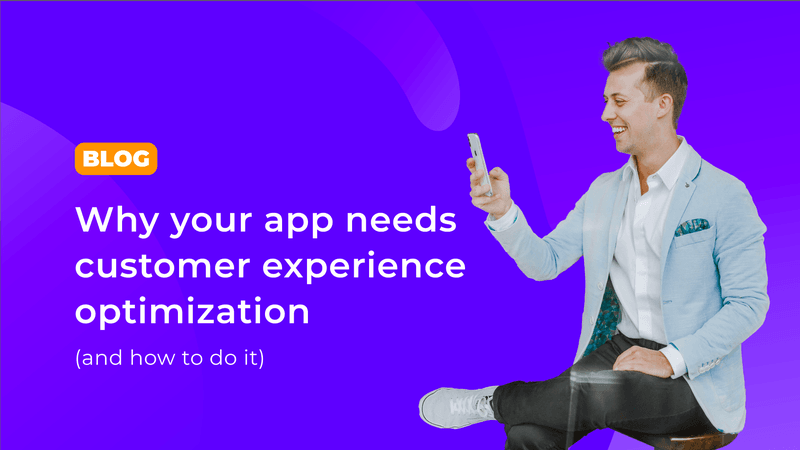The 6 stages of the customer experience and the best ways to improve them in 2023

2022 was an impressive year for mobile apps. In the US alone, consumer spending on apps increased by a whopping $7 billion compared to 2021! But such rapid growth also brings challenges. Is your app ready for what 2023 will bring? Right now, trends are encouraging app publishers to develop customer experience optimization strategies for the complete mobile app funnel. That means building acquisition engines, as well as a sticky reward system that boosts user retention!
In this article, let’s cover how you can optimize your customer journey with the Mobile App Funnel & what gamification can do to power up that strategy.
How 2022 was a big year for apps (and why 2023 will be too)
With a market set to grow 21% every year between 2021 and 2025, things will not stay the same for long. Indeed, a steady ship is rare in a rising tide.
Looking at the app market at the macro level, we see accelerated growth from top to bottom. More than 2 million new apps were published in 2022, bringing the total to a record over 21 million. Of that number, 233 apps make over $100 million annually, up an incredible 20% in just 1 year.
So the statistics show that the stakes are getting higher, the prizes bigger, and the competition stiffer. But 2022 did pick some winners when it came to growth:
Some app categories are excelling when it comes to mobile app engagement

Out of all the app categories, finance is the sector that new users are flocking to most. In 2021, the average number of finance apps used monthly increased by 32.5% compared to 2019. That higher level of mobile app engagement gives more finance apps a chance to gain a loyal customer base! In addition, food retail and mHealth are growing in this metric. However, the market is headed for a shakeup in 2023 due to one development:
5G is on the rise – and users expect speed and efficiency improvements
By the end of 2027, nearly half of all devices will support 5G connections. This will drastically affect the customer experience users can expect to enjoy:
- 5G is 100x faster than today’s 4G
- 5G will allow for more integration of AR and VR tech
- Latency times will reduce from 50 milliseconds to just 1 millisecond!
- Fintech will process faster and more secure mobile payments
- Deeper mHealth integration with wearable devices will eventually become possible

In short, you need to be confident that your customer experience can steer you through the changes up ahead. That means discussing customer experience optimization.
Introducing the Mobile App Funnel: a customer experience optimization technique
The customer journey is a popular concept among marketeers. It helps to visualize what users experience, all the way from acquisition up to becoming a loyal customer. In other words, inquisitive product managers and marketeers looking to optimize their customer journey can benefit from the ‘mobile app funnel’ model.
It may seem overwhelming to picture all your challenges and goals, but a systemic approach can help break it up into manageable segments. The mobile app funnel, or User Lifecycle stages model, gives you the clarity you need to identify the best interventions you might want to take during every stage of customer interaction.

Of course, your challenges and goals will differ depending on the stage. To tackle and achieve them, you must develop a tailored strategy for every segment of the journey. This might seem obvious, but it’s easy to miss some crucial details when you are looking at the big picture. This model helps identify what solutions you need for each stage.
The 6 stages of the mobile app funnel (and how to activate user behavior)
The mobile app funnel helps to map out your customer experience optimization strategy – but to give it extra legs you may want to consider gamification!
Gamification is the use of game-like elements in a non-game context that aims to integrate a genuinely enjoyable and satisfying reward system. StriveCloud knows the potential benefits of mobile app gamification, from a 9% boost to conversion to a 250% jump in social activity just from a simple gamified leaderboard!
With that in mind, let’s see how gamification can activate your users in all 6 stages:
#1 Acquisition: increase your user base
Acquiring users can be difficult and costly. At the end of 2021, the cost per install (CPI) rate across the Google Play Store was $1.22. That’s higher than the average, and much higher than in December 2019 when it was $0.97. In essence, it’s getting more expensive to acquire new users. But that doesn’t mean you are without a solution: a successful App Store Optimization (ASO) strategy can boost your conversions by 10%.
For ASO, word-of-mouth and social media tactics are indispensable. Smarter use of keywords, images, and other tags will increase your app’s ranking in the app store!
The gamification boost: How Revolut gained hundreds of users with a leaderboard
When starting out, Revolut had university leaderboards that encouraged students to sign up. This taps into the need for social relatedness. Simply put, competition is fun. In addition, the reward system built on the prize of a premium membership entices users to sign up! This could generate a buzz, like reviews and high star ratings in the app store that will acquire users and boost your ASO strategy.

#2 Activation: convert acquired users to engaged users
It’s not enough to acquire users, you have to activate them. This entails demonstrating your customer value early on. Most apps lose around 80% of new users in just 1 day! Don’t be like that – instead, optimize and concentrate on your onboarding. In doing so, you could see a 4x times boost to activation metrics!
Onboarding should be short, sweet, and personalized! Fitness apps may want to ask new users their experience level, or fintech app users’ priority (like investing or saving). Subtle touches like this can tell a person that their needs will be met; that they are not simply downloading a one size fits all experience. That’s crucial!
Another thing you can do is give your users a headstart. People are more motivated to complete a goal when there’s already some sort of artificial advancement to it. This is called ‘the endowed progress effect’. Companies like Paypal or Dropbox for instance all use this in their onboarding process, and rightfully so as it can increase onboarding completions by over 10%.
The gamification boost: MuscleBooster uses personalized onboarding to become a Top 10 fitness app
The first thing you want when new users install your app is to immediately see the potential benefits. So when MuscleBooster personalized the customer experience, they gave customers ownership over the user experience – making them more likely to stay.

#3 Retention: incentivize habit formation
To stick around, people need to love your product. That much should be clear! At this stage of your customer experience optimization journey, it’s important to have the right data. Here, user retention metrics on Days 1, 7, and 30 are the most important KPIs to keep in mind. Not only will this help you compare your app to the competition, but it will also provide an anchor point to base your efforts on.
At this stage, one of your most powerful tools is customizing in-app communication.
The gamification boost: Personalization gives Calm a 3x boost to user retention
Calm achieved success by letting users set their own push notifications reminding them to meditate. By personalizing push notifications, Calm not only avoids frustrating new users with clutter, but also helps facilitate habit formation, and in turn, retention.

#4 Re-engagement: a reward system that wins back inactive or churned users
Don’t miss out on users who might lapse, after all, you spent this much effort to get them to this stage! It can be super effective to incentivize lapsed users to return with an enticing reward system, such as by offering ‘free stuff’ like premium membership or discounts on exclusive events/features.
The gamification boost: Cashback offers brought back lapsed users for Revolut
Revolut users were given 6 days to benefit from half-price cashback on purchases at the Notes Coffee café chain in London. The results were incredible! They achieved a 15% user retention rate, improved visit repetition, and won back lost customers.

#5 Monetization: increase revenue & convert free users to paying customers
At this point, your user loves your app! But what can you do to increase user activity and improve that customer’s lifetime value? There’s a range of monetization strategies you can go for, from in-app purchases to monthly subscription models. Each has its advantages that you need to consider, depending on what you can offer users.
The gamification boost: BBVA bank monetized 100,000 loyal customers through a smart reward system
BBVA, a leading Spanish bank, created a gamification strategy fit for the loyalty and monetization stage. As part of their strategy, they launched the BBVA Game, a web app with app tutorials and explanations on how to pay taxes and do transactions online.
With their reward system, customers can spend their earned points from completing challenges by redeeming them for music downloads, movies, smartphones, or even tickets for the La Liga football league. This is the sort of ancillary income that can boost your bottom line. After only 6 months, the BBVA game had over 100,000 users and its users showed an 18% higher satisfaction rate!

#6 Advocacy: a smart strategy that makes people talk about you
A 2015 Nielsen report reveals that 83% of people would trust the recommendations of family or friends. However, only a few brands have mastered the word-of-mouth technique and succeeded in converting their users into proud advocates. Here’s where gamification can make the difference.
Exclusivity is a powerful tool that brands can use at this phase. Think about what would make your users proud to display in front of their friends. More than that, you can reward your advocates for using referral links to register for a new account or simply implementing new incentives that would transform advocacy into a habit.
How StriveCloud can help with your app gamification journey
Just like putting a new splash of paint on artwork is stressful for an artist, implementing new features can be troublesome for app developers. How do you know what you are doing is right? Is this reward system suitable for your app’s users? Will it be easy to adjust or take off, should you need to? With StriveCloud’s app gamification building blocks, you need not worry.
The app gamification blocks allow app publishers to insert, remove, and adjust new features to best suit their users’ needs. It doesn’t require code and can be customized to fit your user experience entirely. Ultimately, this lends your business flexibility – to be sure a competitive advantage in 2023’s fast-moving app market!

